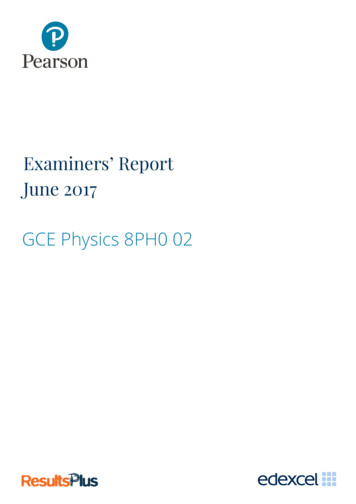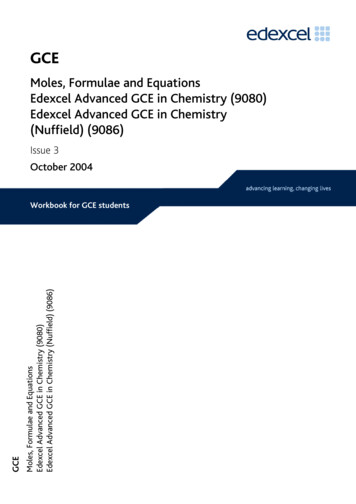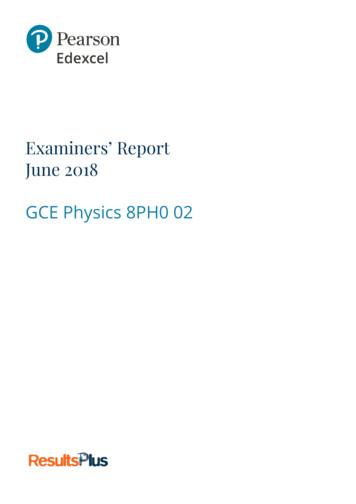
Transcription
Examiners’ ReportJune 2017GCE Physics 8PH0 02
Edexcel and BTEC QualificationsEdexcel and BTEC qualifications come from Pearson, the UK’s largest awarding body. Weprovide a wide range of qualifications including academic, vocational, occupational andspecific programmes for employers. For further information visit our qualifications websitesat www.edexcel.com or www.btec.co.uk.Alternatively, you can get in touch with us using the details on our contact us page atwww.edexcel.com/contactus.Giving you insight to inform next stepsResultsPlus is Pearson’s free online service giving instant and detailed analysis of yourstudents’ exam results. See students’ scores for every exam question.Understand how your students’ performance compares with class and national averages.Identify potential topics, skills and types of question where students may need todevelop their learning further.For more information on ResultsPlus, or to log in, visit www.edexcel.com/resultsplus.Your exams officer will be able to set up your ResultsPlus account in minutes via Edexcel Online.Pearson: helping people progress, everywherePearson aspires to be the world’s leading learning company. Our aim is to help everyoneprogress in their lives through education. We believe in every kind of learning, for all kindsof people, wherever they are in the world. We’ve been involved in education for over 150years, and by working across 70 countries, in 100 languages, we have built an internationalreputation for our commitment to high standards and raising achievement throughinnovation in education. Find out more about how we can help you and your students at:www.pearson.com/uk.June 2017Publications Code 8PH0 02 1706 ERAll the material in this publication is copyright Pearson Education Ltd 20172GCE Physics 8PH0 02
IntroductionThis is the second time that the Pearson Edexcel AS paper 8PH0 02, Core Physics II, has beensat by candidates.Section A of the paper contains eight multiple choice questions followed by questions ofincreasing length and increasing demand. This section examines the Waves and Materialscomponents of the course providing a transition for candidates between GCSE and A Level.Section B contains two questions, with the first question taking inspiration from a shortpassage. With a total of 20 marks, Section B is designed to provide a synoptic element withresponses from any part of the AS specification expected. In this case Question 16 reliedon knowledge from some aspects of dc electricity and Question 17 required use of suvatequations. Candidates seemed prepared for this.This paper enabled candidates of all abilities to apply their knowledge to a variety of stylesof examination questions. Many candidates showed good progression from GCSE to ASlevel, with prior knowledge extended. Some questions were not answered as well as wouldhave been expected by many candidates. Candidates would benefit from more practise ina range of different contexts to become more confident to apply the physics into differentunfamiliar contexts. On this paper in Question 16(b)(ii) candidates were expected to usefamiliar physics contexts in an unfamiliar equation, having to use relevant equations andratios. This may be a skill that many candidates could do with developing further.Some practical and investigative skills were less well-developed than would have beenexpected, as in Question 14. Question 2 showed that many candidates were not confidentwith using an equation for a straight line graph. The teaching and assessment of practicalskills has changed with this new specification into a more progressive approach, allowingcandidates to develop their skills over time.Analysis of multiple choice questionsMulti-choice questions were generally answered well. An 'A grade' candidate could probablybe expected to score at least 6 (with Question 3 and Question 7 scoring less well at thisboundary) and at least 4 or 5 marks for an 'E grade' candidate (Questions 3, 4, 6 and 7scoring less well at this boundary).GCE Physics 8PH0 023
Content12Use of y mx c3Diffractiongratings4Use ofdisplacement vtime graph todetermine phasedifference54Use of extension vmass graph for anextended springEnergy correctresponseCommentAThe work done is found from thearea under the graph. The commonincorrect response showedcandidates forgetting the ½.A, B, CWhilst most candidates scored themarks a significant number werenot confident with rearrangingequations into the format for astraight line graph.CThe common incorrect responsewas linked to wavelength increasinginstead of decreasing.C, DMost candidates got this right buta significant number were not ableto handle phase difference withrespect to the graph and 2π.AThe common incorrect responsewas linked to the correct directionof energy transfer but anincorrect transition of energy - notappreciating that it is the differencein energy levels that is equal to theamount of energy absorbed.The incorrect response showed thatcandidates appreciated that thiswas linked to a factor of 4 due to r2.A quick think to decide whether Pincreases or decreases would havehelped to reconsider their answer.6Use of I P/A56A7Coherent waves86A, CA pleasing high percentage ofcorrect answers.8Ultrasoundscanning90-A pleasing high percentage ofcorrect answers.GCE Physics 8PH0 02
Question 9This was a three mark calculation involving the use of two equations, both given at the backof the paper. Using the de Broglie wavelength equation required a value for momentumwhich could be calculated using p mv with the mass of an electron. This is where somecandidates struggled as the mass of an electron was not given in the question, so theyneeded to realise that this was necessary and that the value is given at the back of the exampaper.A small minority of candidates tried to use the equation velocity frequency x wavelength,probably seeing that the question was about a wave, with a speed given and a wavelengthrequired.Examiner CommentsThis is a 3 mark answer. The candidate hascombined the two equations before substituting thevalues. Full marks were also awarded if a candidatehad calculated the momentum first and thensubstituted that value into the de Broglie equation.Examiner TipIn calculations where the mass of anelectron is required don’t forget thatthis is given in the list of data at theback of the exam paper.GCE Physics 8PH0 025
Examiner CommentsThis is an example of a common incorrect answer.This candidate did not know what to do with thevalue for p and has simply used the value for speedas given in the question.They have tried dividing the speed by the charge onan electron but have not gone on to use this. Somecandidates did use the charge on an electron insteadof mass. Without a value for mass 0 marks could bescored.6GCE Physics 8PH0 02Examiner TipThere is an expectation that someconstants are used even when notspecified in the question.
Question 10 (a)The question refers to the transmitter emitting polarised waves and the receiver onlydetecting waves on a single plane.This means that the receiver will detect maximum amplitude when it is aligned parallelto the polarised microwaves emitted from the transmitter, and zero amplitude when it isperpendicular to the microwaves.The candidates were asked to describe what is heard. As they were not asked to explainwhat was heard it was not necessary to give a full explanation as to why the sound varied asit did.Marks are not awarded for repeating phrases in the question, for example, "audible output".This needed to be related to intensity, amplitude or volume. (Loudness was also accepted.)Examiner CommentsThis candidate writes in terms of the loudnessof the wave and then correctly refers to theorientation at 90o and at 180o.The response gets both marks.Examiner TipMake sure you answer a question fully. Inthis case, a candidate would not have gainedfull marks if they had not correctly referredto both 90o and 180o.GCE Physics 8PH0 027
Question 10 (b)This is a question about the interference of two waves emitted from two gaps in the contextof the microwave transmitter and receiver. Candidates were expected to translate thephysics of interference into different contexts.Many candidates referred to troughs and peaks which is not terminology that is generallyaccepted at this level.Examiner CommentsThis is a good 4 mark answer.8GCE Physics 8PH0 02Examiner TipRemember that if two waves are out-ofphase they are not necessarily in antiphase.For complete destructive interference, andtherefore points of zero intensity, the twowaves need to be in antiphase.
Question 11 (a)This question assesses a candidate's knowledge on how to find the focal point of a diverginglens and to then measure the focal length.The focal length should be measured from the focal point to the central point of the lens. Acommon mistake was to measure to the front edge of the lens which would have resulted ina focal length of less than the required range.Examiner CommentsThis response scored both marks. The two raysare drawn back to the principal axis. The markis given for either dotted or solid lines but twolines must be extrapolated.Examiner TipUse a ruler to draw any ray diagram.The focal length is measured to within thecorrect range for the second mark.GCE Physics 8PH0 029
Question 11 (b)This question required the use of two equations, one to determine the focal length (or 1/focal length) using the object and image distance, and the other that relates focal length tothe power.Examiner CommentsAll 3 marks were awarded for this response. The candidate has clearly used the equation tocalculate 1/f which is then related to P 1/f to give the correct answer of 45.67 and correct unit(Dioptre or D).A common mistake was forgetting to convert cm to m.At the top right of this candidate's answer they have used 1/f with an incorrect value for f.Fortunately they went no further with this and so it was ignored. However, this was commonlyseen, using P 1/f with an incorrect value for f plucked from the diagram (2.4 or 25 or 27.4 were allseen). This would have only scored one mark.Examiner TipDon't forget to convert to SI units when using formulae.10GCE Physics 8PH0 02
Question 11 (c)This question is assessing the candidate's knowledge that adding an additional lens wouldincrease the overall power, which in turn decreases the focal length.A common misconception that became apparent was that the image would be formed atthe focal length in this case so that the focal length should be equal to depth of the eye.That is only the case if the rays were coming from a distant object so that they may beconsidered to be parallel.Examiner CommentsThis candidate clearly understands that the powerwould increase and is awarded the mark.GCE Physics 8PH0 0211
Question 12 (a)This question posed little problem for those who had learnt a definition for a virtual imagebut this had clearly not been covered by all candidates.Those who got this correct wrote the second alternative on the mark scheme that a virtualimage cannot be projected on to a screen.Examiner CommentsThis is the correct answer for 1 mark.Examiner TipMake sure you understand and can describe thedifference between a real and a virtual image.Examiner CommentsThis shows an example of an incorrect answer from a candidatewho had not learnt a definition for a virtual image.12GCE Physics 8PH0 02
Question 12 (b)This question concerns refraction and total internal reflection being assessed in anunfamiliar context. The candidates were required to work through the physics of mirages toarrive at a conclusion. Mirages are formed when light is refracted by air of increasingtemperature closer to the ground. The simplified model described in the question useslayers to represent the air at different temperatures. The light is refracted until the angle ofrefraction at a particular layer is greater than the critical angle. Then total internal reflectiontakes place and the light is reflected towards the observer. To the observer it appears as ifthe light is coming from the road and a virtual image is formed.Most candidates carried out a calculation but the lack of correct terminology and the abilityto express ideas clearly let many candidates down.For example:"the light hits the interface" is better expressed as "light is incident on."Omitting the "total" from total internal reflection.Despite the hint in part (a) some candidates thought that since the ray is being reflectedaway from the road no image is formed.Examiner CommentsThis is a near perfect answer which scored 5 marks, missing out only on MP6.In the first two lines a correct calculation of the refraction angle as 89.8o gains the first three marking points.It demonstrates an appreciation that the light is refracted as a refraction equation is used.On line 7, reference is made to angle of incidence being greater than the critical angle. It was insufficientto state simply that "it" is greater than the critical angle since their calculation has determined an angle ofrefraction between layers 1 and 2. The candidate needed to make it clear that they are now referring to theangle of incidence at layer 2 to 3. This should then lead to total internal reflection. This candidate realisesthat the light does not reach the road but does not state that to the observer it appears to.GCE Physics 8PH0 0213
Examiner CommentsThis answer scores all 6 marks.14GCE Physics 8PH0 02
Question 13 (a)This is a question that relies on knowledge of weight mass x density and Stokes Law. Acandidate who worked methodically from the given starting point of the derivation couldachieve all three marks.Examiner CommentsAll 3 marks are achieved in the first line of thisresponse. The terms given by the candidate arewritten in the same order as shown in the questionso it can be assumed that the candidate knowswhich term relates to weight, to drag and toupthrust.Examiner TipCredit is not usually given to a candidatewho has clearly worked backwards fromthe final equation.GCE Physics 8PH0 0215
Question 13 (b) (i)Most candidates were able to achieve some marks on this question with full marks seenfairly frequently. Quite a number of candidates could not remember the equation for avolume of a sphere. Perhaps they had not memorised this, expecting it to be at the backof the paper. The units for viscosity were not well known although some got round this byapplying units to the equation and arriving at the units in base units.Candidates needed to make use of the equation on the previous page. Velocity v needed tobe calculated from the information given in the question, as well as the volume of thesphere.Examiner CommentsFull marks were awarded for this response.Speed (0.13 m/s) is calculated in the first twolines for MP1.A calculation for volume is shown on the righthand side for MP2.Both of these are substituted correctly into theequation on lines 5-7 to arrive at the correctfinal answer of 1.8. Although the unit Pa s isnot given here it is written on the answer line.16GCE Physics 8PH0 02Examiner TipMake full use of a copy of the dataand formula sheet from the back of anexam paper throughout your course.That way you will become familiar withconstants and formulae that are providedfor you and where to find them. Somemathematical formulae such as the area ofa circle and the volume of a sphere are notgiven. You need to learn these.
Examiner CommentsThis is an example of a candidate achieving thecorrect numerical answer who has given incorrectunits. The candidate has had a valid attempt todetermine alternative units using base units (theirworking is shown) but has unfortunately notarrived at a correct answer so achieves 3 marks.Alternative units accepted are kg m-1 s-1 or N s m-2.Examiner TipIf you cannot remember the unit auseful skill is to substitute units into anequation to arrive at alternative units fora quantity.GCE Physics 8PH0 0217
Examiner CommentsThis response gets 3 marks.It has the correct numerical answer but incorrect units.18GCE Physics 8PH0 02
Question 13 (b) (ii)This requires a practical application of Stokes law. The question was not well answered.A wider cylinder should be used as Stokes law applies when the sphere is falling in laminarflow and so reaches a steady velocity.Examiner CommentsThis is an example of a rare correct answer which was awarded 2 marks.Examiner CommentsAlthough the candidate has chosen the correct cylinder no marks are scored as the reason isincorrect.A common insufficient answer was to mention that the ball would hit the sides of the cylinder.GCE Physics 8PH0 0219
Examiner CommentsA candidate may score marks by giving a reason in terms of the wider cylinder or why not thenarrower cylinder. This candidate scores 1 mark for the idea that the narrower cylinder doesnot have laminar flow. The implication then is that the wider cylinder does have laminar flow.20GCE Physics 8PH0 02
Question 14 (a)This is a question where a candidate could have scored full marks if they had learnt adefinition for a longitudinal wave. It seemed as if candidates had not expected this question.For MP2 there needed to be reference to oscillations of particles and the direction in whichthese oscillations occur - parallel to the direction of the propagation of the wave.Examiner CommentsThis is an example of an answer scoring 2 marks.Longitudinal wave for MP1.Examiner TipWhen describing a longitudinal wave it isimportant to mention the particles.Particles oscillating in the direction of thepropagation of the wave for MP2.Examiner CommentsThis response was awarded one mark only for longitudinal waves. The candidate has the ideaof the transfer of energy through particles but has not expressed this well.GCE Physics 8PH0 0221
Question 14 (b) (i)On the first day students only took two measurements but felt the need to take a thirdmeasurement on the second day. This is because the two results taken on the second daywere very different to each other so a third measurement would establish which theanomaly was.Examiner CommentsThis is an example of an answer which was awarded the mark.It is insufficient to state that the readings were not in agreement as this does notestablish in which way the results were not in agreement.Examiner CommentsBefore taking the third measurement the students would not have knownwhich result was the anomaly. This response is not awarded a mark.22GCE Physics 8PH0 02
Question 14 (b) (ii) - (iv)This question was an analysis of a straightforward practical that can be easily carried out atschool.(ii) Many candidates were correctly able to calculate uncertainty.(iii) A use of v s/t. The most common error was to use s 80 m, forgetting the factor of 2.(iv) M ost students offered suggestions but these were often too vague showing littleprogress from GCSE. For example: simply stating 'human error' is insufficient,but qualifying this by stating 'human reaction time' is accepted. After completing anexperiment in the lab thinking about the results obtained will be of benefit, askingquestions such as 'how accurate is our result?', 'how could we make it more accurate andreduce uncertainties?', 'what other factors need to be taken into account?'.GCE Physics 8PH0 0223
Examiner CommentsThis response was awarded full marks in all parts - (b)(ii), (iii) and (iv).24GCE Physics 8PH0 02
Question 14 (c) (i)This was a challenging question assessing the application of the reduction in the energy inwaves as they move through a distance and standing waves.Points A and B are nodes in the standing wave formed from destructive interferencebetween the outgoing wave from the loudspeaker and the reflected wave from thereflecting board. These waves at point B will have similar amplitude as they have travelledsimilar distances and so near destructive interference occurs and the intensity at B is almostzero. At A the two waves have travelled different distances and so will have differentamplitudes. The destructive interference will not be as complete, and so the intensity at A isgreater than it is at point B.Examiner CommentsThis is an example of a common 1 mark answer. This candidate has ignored the fact that this isa standing wave but achieves 1 mark for MP1.GCE Physics 8PH0 0225
Examiner CommentsThis candidate recognises this as a standing wave (line 1) and understands that intensity of awave decreases with distance travelled (lines 3 and 4). Sadly they have not built on this andthe final bullet point ignores the standing wave. The response scores 2 marks.26GCE Physics 8PH0 02
Question 14 (c) (ii)As explained in the question there is a standing wave set up between the loudspeaker andthe reflecting board. The distance between nodes in a standing wave is equal to half thewavelength. The low points shown in the graph are the nodes (destructive interference) sothe distance from A to B will be one wavelength or the distance between adjacent nodes ishalf a wavelength.Taking a measurement from the graph between A to B gives one wavelength as 0.16 m.Most candidates used the correct equation but could score no more than one mark if theydid not use a wavelength equal to 0.16 m.Examiner CommentsThis correct answer scores 3 marks.A common, incorrect answer was 160 m s-1 having used a value for wavelength of 0.08 mwhich is the distance between adjacent nodes - a candidate not appreciating that the graphis representing a standing wave.GCE Physics 8PH0 0227
Question 15This question provided an open response to explain the observations made in thephotoelectric effect. This lack of scaffolding assessed a candidate's ability to recognise whatwas relevant in order to explain the bullet points in the question.There was a tendency for some to write far more than was necessary. Be very wary ofrepeating the information in the question. The points that are made are referring tofrequency so answers were expected that made the link to energy of the photon or energyof the photoelectron. Some who did make the link to energy did not always make it clearwhether they were referring to photons or electrons. The equation E hf was often seen justwritten down without any reference to photons. This would have gained no credit as thecandidate did not fully demonstrate that they understood the significance of the equation,only that they knew it was relevant.Some answers failed to mention photons (or equivalent) at all, or to fully answer thequestion making no reference to waves.28GCE Physics 8PH0 02
Examiner CommentsThis response scores 5 marks.Indicative point 1: at the very end.Indicative point 2: lines 1 and 2 - equation stated and linked to energy of photon.Indicative point 3: lines 3 to 8.Indicative point 4: not seen.Indicative point 5: lines 8 to 12.Indicative point 6: lines 12 to 14.Total number of indicative points 5 which gives 3 marks plus 2 linkage marks giving a total of 5marks.Examiner TipConsider using bullet points to write a well-structured, concise answer. Just ensurethat the points made are in a logical order and points are clearly linked.GCE Physics 8PH0 0229
Examiner CommentsThis response scores 1 mark.This is a poor answer, with no mention ofphotons. E hf is stated but with no reference toenergy of photons so this gains no credit.Although poorly expressed MP5 is just aboutawarded in the second half. With only oneindicative point seen there can be no linkage andtherefore no linkage mark awarded.30GCE Physics 8PH0 02Examiner TipPhotons are an important concept inphysics and use of photons is expectedwhen writing about the photoelectriceffect.
Examiner CommentsThis answer starts off well.Indicative point 1: line 3 and also lines 5 and 6.Indicative point 2: lines 5 to 7.Indicative point 3: lines 4 and 5.There is no clear reference to waves.Indicative points 3 which gives 2 marks 1 linkage mark: total 3 marks.GCE Physics 8PH0 0231
Question 16 (a)The most common reason given was the need for no further calculation, and mostcandidates were able to gain at least 1 mark.Using two devices instead of one increases the overall uncertainty in the measurement.Most candidates did not appreciate this.Examiner CommentsThis is an example of a common 1 markanswer.There was a misconception that an ohmmeterdoes not need a current. Whilst it should notbe used with an external power source it doesproduce its own small current.32GCE Physics 8PH0 02Examiner TipMake sure you know how to measureresistance using an ohmmeter as well asusing a voltmeter and an ammeter.
Examiner CommentsThis answer failed to score any marks as it is too vague.GCE Physics 8PH0 0233
Examiner CommentsThis response scores 2 marks.They have the idea that one device will have less uncertainty compared to two and that acalculation is needed when using an ammeter and voltmeter. (It is assumed that ‘the othermethod’ is the ammeter and voltmeter.)There is nothing of credit in line 4.34GCE Physics 8PH0 02
Question 16 (b) (i)Increasing the length of a wire increases overall resistance, so the applied force will causethe length and hence the resistance to increase.Examiner TipExaminer CommentsThis answer scored both marks. Referenceto a change in the cross-sectional areais ignored but this candidate also referscorrectly to the length and justifies theiranswer with the relevant equation.Take note when a question asks you to‘justify’. In this case it can be done by quotingan equation and referring to the quantities inthe equation.Stating that the ‘resistance changes’ isinsufficient. This is stated in the question.Examiner CommentsThis is a good 2 mark answer.GCE Physics 8PH0 0235
Question 16 (b) (ii)This was a question involving the substitution of values into an unfamiliar equation.Candidates needed to use two ideas: that ΔR/R 0.1% 0.001 that strain ε Δw/w and so ε Δw/0.05.With both of these substituted into the equation, the equation can then be rearranged tofind change in width.Examiner CommentsThis answer scored all 3 marks.0.1/100 can be seen on the first line of working anda value for the strain calculated. On the second lineof working the correct expression for the strain hasthen been used to determine the change in width.36GCE Physics 8PH0 02Examiner TipThe ratio between two values may begiven as a numerical value between 0and 1, or as a percentage.
Examiner CommentsThis also scores 3 marks.This candidate has arrived at a value for the ratio of the resistances by making an assumption thatR 1 and so the change in resistance is 1x10-3. This is numerically equal to expressing 0.1% as afraction.A common mistake seen was to substitute (ΔR)/R 1.001, a correct manipulation of the % changein R (0.1%) which has then been added to 1.0. Remember, the ratio (ΔR)/R cannot be greater than 1,since the change in resistance is (considerably) less than 100%.GCE Physics 8PH0 0237
Examiner CommentsThis response also scores 3 marks.In the last two lines of the working both correct substitutions are made: ε Δx/0.05 and ΔR/R 0.1/100.Rearranging the equation then gives the correct numerical answer for the final mark.38GCE Physics 8PH0 02
Question 16 (c)This is about the ability to detect a change in the resistance - the longer the wire the greaterthe change in resistance. It is the change in resistance that needs to be measured.The answer should be a comparative answer since you are giving a comparison betweentwo different things: the zig zag pattern and not using the zig zag pattern.Examiner CommentsThis is a good 2 mark answer.‘bigger change in length’ - comparativeanswer.Examiner TipAn answer is comparative by using theadjectives 'longer', 'shorter', 'greater'etc.‘increases the change in resistance’ - acomparative answer describing a change inresistance.Examiner CommentsThis answer scores zero. ‘More wire’ is not specific enough.GCE Physics 8PH0 0239
Examiner CommentsThis is a typical 1 mark answer - links to an increase in length but no mentionof the change in resistance.40GCE Physics 8PH0 02
Question 17 (a)Section B can cover any part of the AS specification. On Paper 2, one question will contain awritten passage. Question 17 on this paper is the passage question. Candidates areexpected to read through the passage and then answer questions. The questions can beframed such that candidates are expected to use information given in the passage or usethe information in the passage to provide a stimulus from which the questions can build.Both parts (a) and (b) require the candidate to make a conclusion. The command word'deduce' indicates this.The candidate is asked to deduce whether the claim about weightlessness is true.Candidates are expected to know that a falling object will feel weightless if their accelerationis equal to g. In order to answer the question, the acceleration of the rider needs to becalculated and this value compared to 9.81 m s-2.This requires correct use of a suvat equation, or a combination of suvat equations.Examiner CommentsThis response scores 3 marks.The candidate has used the correct suvat equationto calculate a value for acceleration of 9.61 m s-2.They then give a valid conclusion by comparing 9.61to 9.81.Examiner TipIf two values are being compared inorder to make a conclusion, then thetwo values being compared must be thesame type of quantity, in this case bothaccelerations.The conclusion needs to be consistent with theircalculated value. In this case, a correct calculatedvalue may give one of two conclusions:- is not weightless since 9.61 is less than 9.81OR- is nearly weightless since 9.61 is approximatelyequal to 9.81.GCE Physics 8PH0 0241
Examiner CommentsThis response scores 1 mark.This candidate has not carried out the calculation correctly (they have calculated a velocity notan acceleration). However, they have compared their answer with 9.81 and made a correctco
GCE Physics 8PH0 02 3 Introduction This is the second time that the Pearson Edexcel AS paper 8PH0 02, Core Physics II, has been sat by candidates. Section A of the paper contains eight multiple choice questions followed by questions of increasing length and increasing demand. This section examines the Waves and Materials










